Human Orbital Spaceflights
![]()
International Flight No. 65Soyuz 30KavkazUSSR |
 |
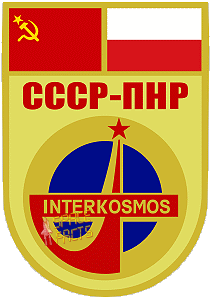 |
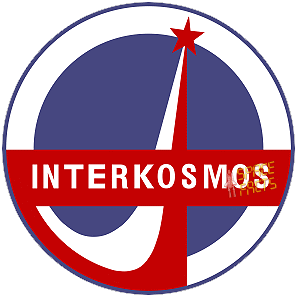 |
||
![]()
Launch, orbit and landing data
walkout photo |
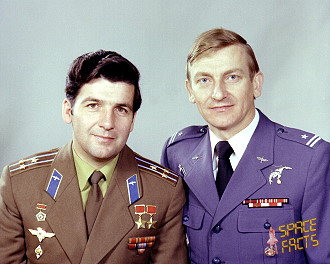 |
|||||||||||||||||||||||
alternative crew photo |
alternative crew photo |
|||||||||||||||||||||||
alternative crew photo |
alternative crew photo |
|||||||||||||||||||||||
alternative crew photo |
alternative crew photo |
|||||||||||||||||||||||
Crew
| No. | Surname | Given names | Position | Flight No. | Duration | Orbits | |
| 1 | Klimuk | Pyotr Iliyich | Commander | 3 | 7d 22h 02m 59s | 125 | |
| 2 | Hermaszewski | Miroslaw "Mirek" | Research Cosmonaut | 1 | 7d 22h 02m 59s | 125 |
Crew seating arrangement
|
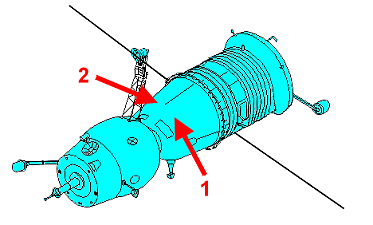 |
|
||||||||||||
Backup Crew
|
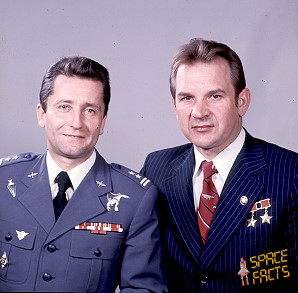 |
|||||||||||||||
alternative crew photo |
||||||||||||||||
alternative crew photo |
Hardware
| Launch vehicle: | Soyuz-U (No. Yo15000-147) |
| Spacecraft: | Soyuz 30 (7K-T No. 67) |
Flight
|
Launch from the Baikonur Cosmodrome and
landing 101 km northeast of Arkalyk. Soyuz 30 was the second Intercosmos mission. Miroslaw Hermaszewski became the first cosmonaut from Poland. Following a one-day solo flight Soyuz 30 docked with the Salyut 6 space station on June 28, 1978 and the crew performed common work with the second resident crew. Once all the necessary checks had been made, the Soyuz 30 crew opened their hatch and moved into the station, where they were greeted by the two resident crewmembers. There was a traditional greeting consisting of bread and salt, along with a little fruit juice in glasses they could clink for good luck. After a familiarization tour of the station the cosmonauts began that day's program of scientific experiments. Experiments on the field of materials science were performed. Photography of the Earth surface and study of the aurora borealis were done together with the second resident crew. The activities of the Soyuz 30 crew, however, were severely curtailed so as not to interfere with the Soyuz 29 crew. On the Soyuz 29 crew's rest day, the international crew had to stay in their Soyuz to perform their experiments. Nevertheless, Miroslaw Hermaszewski conducted many experiments. One was crystallization experiments which produced 47 grams of cadmium tellurium mercury semiconductors for use by infra-red detectors on board the station. The yield was far greater - 50% compared to 15% - than ground-based experiments. Miroslaw Hermaszewski participated in medical experiments which measured lung capacity and the heart during exercise and in a pressure suit. One experiment, which all four on board the station participated in, was Smak, a taste experiment which sought answers to why some food was less palatable in weightlessness. The Soyuz 30 crew was trained, as all international crews, in the use of the MKF-6M camera. Training in part took place on a Tu-134 flying at 10 km to best mimic conditions on the station. Miroslaw Hermaszewski photographed Poland in co-ordination with aircraft taking close-up photos, but bad weather over Poland limited the photo sessions. They additionally filmed the Aurora Borealis. MKF-6M was not simply a matter of point and shoot; first the camera had to be primed, then the Salyut station had to be oriented to aim the camera directly at the ground when the photograph had to be taken. The experiments in detail: Sirena: Consisted of two experiments, one in the Splav furnace, the other in the Kristall furnace aboard Salyut 6. The aim of the experiment in the Splav furnace was to study the process of directed crystallization of semiconductor materials from the liquid phase in zero-g. For this purpose, a cylindrically shaped crystal of the triple semiconductor "mercury-cadmium-tellurium" (HgCdTe) was placed in a quartz ampoule and melted in the furnace, after which it was cooled and allowed to solidify. Afterwards it is removed from the furnace and returned to Earth. HgCdTe semiconductor alloys are hard to obtain in gravity because the three elements have significantly different atomic weights and convection processes (resulting from gravity) make it difficult to ensure those alloys remain homogenous. HgCdTe semiconductor crystals have been studied for many years by the Physics Institute of the Polish Academy of Sciences. Their main application is in infrared detectors, more particularly in detectors capable of detecting radiation with a wavelength of about 10 micrometers, which is in the atmospheric "window" where water vapour and other components don't absorb this radiation. Such materials can also be used in semiconductor lasers. It was expected that HgCdTe crystals obtained in zero g would be more homogeneous and have a more perfect crystalline structure. The experiment was prepared in collaboration with the Institute of Space Sciences (IKI). The experiment in the Kristall furnace was aimed at studying the crystallization of semiconductors consisting of lead-selenium-tellurium (PbSeTe) or cadmium sulphide with small additions of selenium (PbSnTe) from the gaseous phase. The materials were placed in a quartz ampoule together with a monocrystal plate consisting of the same materials. During heating the materials vaporized and turned into a monocrystal, forming a layer on the monocrystal plate, which has a lower temperature. After the experiment the ampoule was extracted from the furnace and returned to Earth. Triple semiconductors based on lead are used in infrared semiconductor lasers. They are only effective if they have a homogenous structure and this is difficult to obtain on the ground. The experiment was prepared in collaboration with IKI. Opros (Questionnaire): An experiment designed to study how comfortable life in space is and to study work efficiency in space. For this purpose, the Military Institute of Aviation Medicine (Poland) together with Soviet specialists developed a questionnaire. The cosmonauts were supposed to answer questions about various factors on a scale of one to five (e.g. sleep patterns, taste of food, interactions between international crew members, adaptation to the new conditions). Vkus (Taste): The experiment studied changes in taste patterns in zero gravity by electric stimulation of the taste nerves using a Polish device called an "elektrogustometr". This device generated sawtooth voltage, making it possible to produce an alternating current between electrodes (from 0 to 300 microamperes) and a digital measuring system. The experiment used two electrodes, one placed on the tongue and the other on the hand. The electric impulses would generate either a metallic or a sour taste. The system measured the current required to cause a sense of taste. Dosug (Leisure time): The Military Institute of Aviation Medicine (Poland) and Polish television along with Soviet specialists recorded several four-hour television programs. The cosmonauts had to judge them by making notes in a special section of their on-board journals. The results would have been used to more effectively organize leisure time in space. Kardiolider: The crew measured changes in the heart rate using the Kardiodiler-D01 instrument, developed by the Factory of X-Ray and Medical Equipment in Warsaw. Kardiodiler-DO1 is a portable device weighing 200 grams, which has an autonomous power supply and in conjunction with electrodes placed on the body can measure changes in the heart rate (in a range from 60 to 180 beats per minute). The first part of the experiment was conducted during the second flight day while the cosmonauts are wearing the Chibis vacuum suit. If there were any signs that the cosmonaut's condition deteriorated and the heart rate exceeded 100 beats per minute, the experiment would be automatically stopped. The second part of the experiment was conducted during the third day of the flight while the cosmonauts were doing physical exercises on the VEL-1 stationary bicycle. In the first training mode their heart rate reached up to 130 beats per minute and in the second training mode up to 150 beats per minute. If the heart rate exceeded the given parameters in the first mode, the cosmonaut would slow down the speed. If the heart rate exceeded the given parameters in the second mode, the cosmonaut would stop the exercise. The experiment was designed to help find efficient ways to prevent cardiovascular problems during long-duration missions and to help maintain work capacity during all stages of the flight. Other experiments were: The crew continued the "Kislorod", "Teploobmen" and "Khlorella" experiments begun by the Soviet-Czech crew and also took pictures of the Earth in the interests of the national economy. They also took part in a medical experiment to study the reactions of the cardiovascular system to simulated gravity in the Chibis suit. The book "Orbity Sotrudnichestva" also mentions a medical experiment to study blood circulation using devices known as Polinom-2M, Reograf and Beta. The Soyuz 30 crew packed their experiments into their capsule and returned to earth July 05, 1978. The Soyuz spacecraft is composed of three elements attached end-to-end - the Orbital Module, the Descent Module and the Instrumentation/Propulsion Module. The crew occupied the central element, the Descent Module. The other two modules are jettisoned prior to re-entry. They burn up in the atmosphere, so only the Descent Module returned to Earth. The deorbit burn lasted 188 seconds. Having shed two-thirds of its mass, the Soyuz reached Entry Interface - a point 400,000 feet (121.9 kilometers) above the Earth, where friction due to the thickening atmosphere began to heat its outer surfaces. With only 23 minutes left before it lands on the grassy plains of central Asia, attention in the module turned to slowing its rate of descent. Eight minutes later, the spacecraft was streaking through the sky at a rate of 755 feet (230 meters) per second. Before it touched down, its speed slowed to only 5 feet (1.5 meter) per second, and it lands at an even lower speed than that. Several onboard features ensure that the vehicle and crew land safely and in relative comfort. Four parachutes, deployed 15 minutes before landing, dramatically slowed the vehicle's rate of descent. Two pilot parachutes were the first to be released, and a drogue chute attached to the second one followed immediately after. The drogue, measuring 24 square meters (258 square feet) in area, slowed the rate of descent from 755 feet (230 meters) per second to 262 feet (80 meters) per second. The main parachute was the last to emerge. It is the largest chute, with a surface area of 10,764 square feet (1,000 square meters). Its harnesses shifted the vehicle's attitude to a 30-degree angle relative to the ground, dissipating heat, and then shifted it again to a straight vertical descent prior to landing. The main chute slowed the Soyuz to a descent rate of only 24 feet (7.3 meters) per second, which is still too fast for a comfortable landing. One second before touchdown, two sets of three small engines on the bottom of the vehicle fired, slowing the vehicle to soften the landing. |
Photos / Graphics
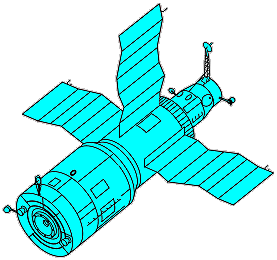 |
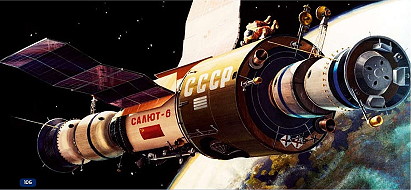 |
 |
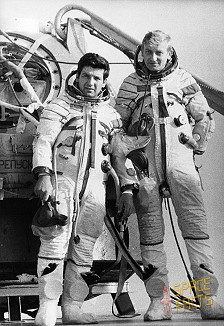 |
 |
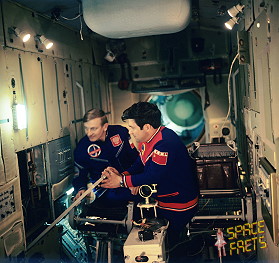 |
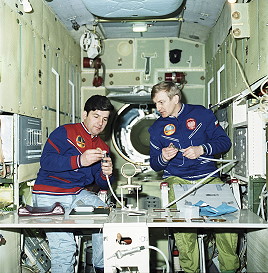 |
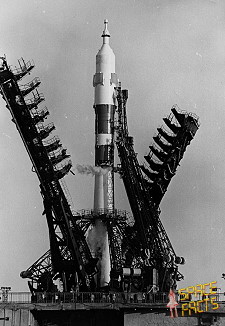 |
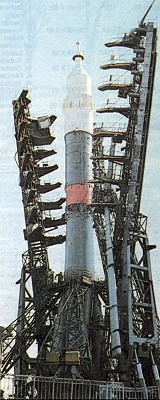 |
 |
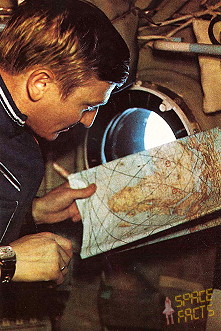 |
 |
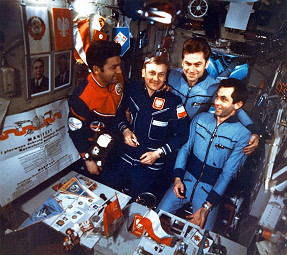 |
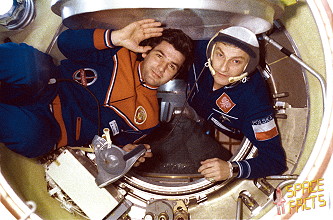 |
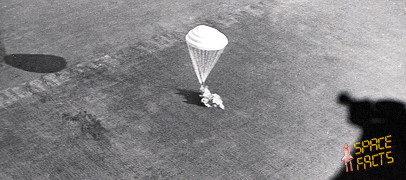 |
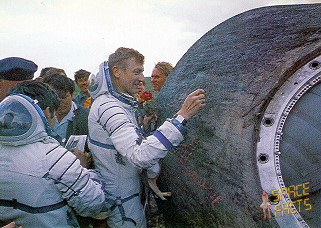 |
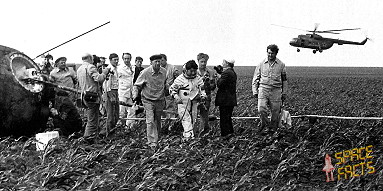 |
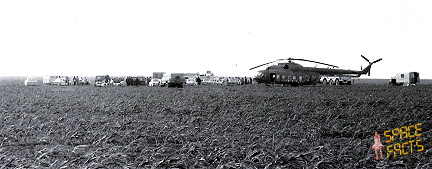 |
| © |  |
Last update on June 28, 2023.  |
 |